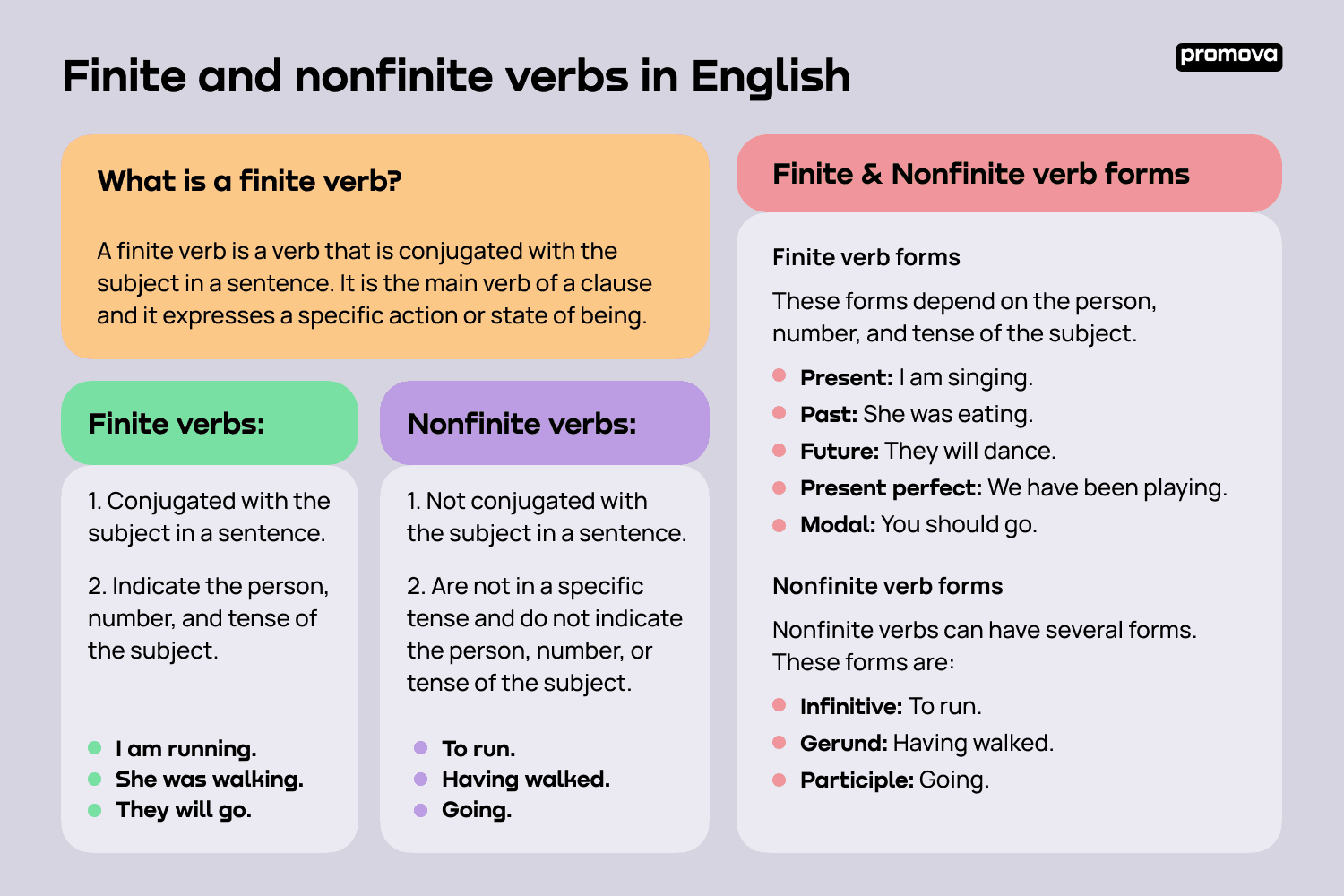Finite and nonfinite verbs in English
Contents
Finite and nonfinite verbs sound like a confusing topic, but in reality, it all comes down to conjugation! In this reference, we will discuss what a finite verb is, the difference between finite and nonfinite verbs, examples of finite and nonfinite verbs, and the rules for you to practice!
What is a finite verb?
A finite verb is a verb that is conjugated with the subject in a sentence. It is the main verb of a clause and it expresses a specific action or state of being. Finite verbs are usually in the present, past, and future tenses. They are conjugated with the subject and indicate the number and person of the subject. Finite verbs are also known as "main verbs" or "lexical verbs".
Difference between finite and nonfinite verbs
Finite and nonfinite verbs are two different types of verbs in English. Finite verbs are the ones that are conjugated with the subject in a sentence. They indicate the person, number, and tense of the subject. Nonfinite verbs are not conjugated with the subject in a sentence. They are not in a specific tense and do not indicate the person, number, or tense of the subject.
The difference between finite and nonfinite verbs is that finite verbs are conjugated with the subject in a sentence while nonfinite verbs are not. Finite verbs indicate the person, number, and tense of the subject while nonfinite verbs do not. Finite verbs are the main verbs of a clause while nonfinite verbs are usually auxiliary or modal verbs. 
Examples of finite and nonfinite verbs
Finite verbs:
- I am running.
- She was walking.
- They will go.
Nonfinite verbs:
- To run.
- Having walked.
- Going.
Examples of finite verbs in sentences
Finite verbs in sentences indicate the person, number, and tense of the subject. Examples of finite verbs in sentences:
- I am singing alone.
- She was eating ramen.
- They will dance tomorrow.
- We have been playing for hours.
- You should go home.
Finite verb forms
Finite verbs can have several forms. These forms depend on the person, number, and tense of the subject. Here are some examples of finite verb forms:
- Present: I am singing.
- Past: She was eating.
- Future: They will dance.
- Present perfect: We have been playing.
- Modal: You should go.
6
Nonfinite verb forms
Nonfinite verbs do not indicate the person, number, or tense of the subject. They are not conjugated with the subject in a sentence. Nonfinite verbs can have several forms. These forms are:
- Infinitive: To run.
- Gerund: Having walked.
- Participle: Going.
Finite verbs in different tenses
Examples of finite verbs in different tenses:
- Present: I am singing.
- Past: She was eating.
- Future: They will dance.
- Present perfect: We have been playing.
- Past perfect: You had gone.
- Future perfect: We will have been singing.
Finite verb rules
Finite verbs have several rules. Here are some of the rules for using finite verbs:
Finite verbs must agree with the subject in person, number, and tense.
For example, if the subject is “I”, the verb must be in the first person singular form (e.g., “I am singing”).
Finite verbs must be conjugated with the subject.
For example, the verb “work” must be conjugated to “I am working” when the subject is “I”.
Finite verbs must be in the correct tense.
For example, if the sentence is in the past tense, the verb must be in the past tense form (e.g., “She was eating”).
Finite verbs must be used in the right context.
For example, the verb “can” is only used in the context of possibility (e.g., “I can go”).
Summary
Finite verbs can have several forms, depending on the person, number, and tense of the subject. With time, you should learn to easily add them to sentences. Remember the rules of conjugation and tenses, from there it's quite an easy job. Take your time and practice finite verbs in your language studies!
Comments